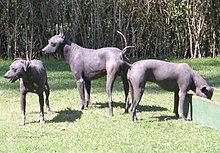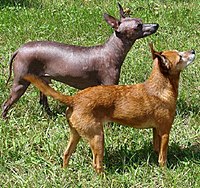Xoloitzcuintle
| Xoloitzcuintle | |||||||||
|---|---|---|---|---|---|---|---|---|---|
 Group of three Mexican Hairless Dogs | |||||||||
| Other names | Xoloitzcuintli Xoloitzcuintle Xoloitzquintle | ||||||||
| Common nicknames | Xolo | ||||||||
| |||||||||
| Dog (domestic dog) | |||||||||
The Mexican Hairless Dog is a rare, hairless breed of dog whose size varies greatly. It is also known as Xoloitzcuintli or Xoloitzcuintle (in English Template:PronEng shoh-low-eats-quint-lee), or Mexican Hairless. Most owners of this dog call them "Xolos" or "MHD"s for short.[citation needed]
Appearance
The breed ranges in size from about 10 pounds/4 kg to 50 pounds/20 kg, with an average body temperature of 104 °F/40 °C. Similar in appearance to a Pharaoh Hound, with a sleek body, almond-shaped eyes, large bat-like ears, and a long antelope neck, the Xolo is notable for its dominant trait of hairlessness. Many members of this breed are also missing several teeth.[citation needed] There is also a "coated" Xoloitzcuintli with a very short coat of hair, and individual dogs may exhibit varying degrees of head and body coats. Most hairless dogs are black or blue in color. Most Xoloitzcuintli mothers give birth to only a few hairless puppies and the rest slightly coated with a slim thatch of fur. Its ugly.
History
The breed is native to Pre-hispanic Mexico, and may date back up to 3,500 years ago. Xolos were considered sacred dogs by the Aztecs because they believed the dogs were needed by their masters’ souls to help them safely through the underworld. According to Aztec mythology, the god Xolotl made the Xoloitzcuintle from a sliver of the Bone of Life from which all man was made. Xolotl gave this gift to Man with the instruction to guard it with his life and in exchange it would guide Man through the dangers of Mictlan, the world of Death, towards the Evening Star in the Heavens. A true to breed dog should have had dark skin not the pink skin that is sometimes seen. The Aztecs also raised the breed for their meat. 16th century Spanish accounts tell of large numbers of dogs being served at banquets.[1]
Even today many people in Mexico believe this breed to have healing qualities. Some cultures ate the meat of the Xoloitzcuintli for ritual or medicinal purposes, and the meat may still be found for sale in some parts of rural Mexico.[citation needed]
Xoloitzcuintles are not currently fully recognized by the AKC but are now accepted as foundation stock and will be accepted within the next few years, making them a rare breed in the United States. The breed is recognized by the FCI through the Mexican Kennel Club (Federación Canófila Mexicana). The FCM began a registration and breeding program for the Mexican hairless dog on May 1, 1956. Prior to that time the Xoloitzcuintles were considered nearly extinct. New breed stock is still found in remote pockets of rural Mexico.

References
- ^ Coe, Sophie D. (1994) America's first cuisines ISBN 0-292-71159-X
